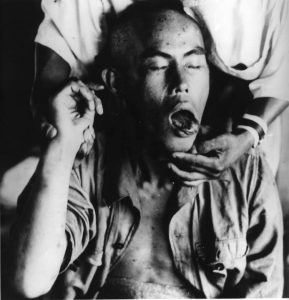Documenting Hiroshima of 1945: August 30, “This is not going to be easy”
Aug. 30, 2024
Radiation medicine survey team arrives
by Kyosuke Mizukawa, Senior Staff Writer
On August 30, 1945, a joint survey team made up of Masao Tsuzuki, a professor at Tokyo Imperial University (present-day University of Tokyo), as well as instructors from Japan’s Army Medical School, arrived in Hiroshima City by train. Mr. Tsuzuki was an expert in radiation medicine and the person who diagnosed Midori Naka, an actor who had died in Tokyo on August 24, with “A-bomb disease.”
The survey team’s base of operations was within the Ujina Branch of the Hiroshima First Army Hospital, established at the Army’s Marine Training Division in the area of Ujina-cho (in Hiroshima’s present-day Minami Ward). Currently, Mazda Motor Corporation’s Ujina Plant includes the former site of the Ujina Branch, which cared for around 500 seriously wounded patients at that time. According to Mr. Tsuzuki’s personal notes carried in the journal Seitai (in English, ‘Ecology’), published in 1953, when Mr. Tsuzuki arrived on site, he sensed that, “This is not going to be easy.”
“Extreme fear”
In his personal notes, Mr. Tsuzuki also wrote, “Many of those who were once pleased they did not have any external injuries began to successively develop so-called A-bomb disease. They died in seemingly never-ending waves, leaving the local population with feelings of extreme fear and despair … .”
Many of the patients he saw suffered from fever, subcutaneous hemorrhagic spotting over the body, and bleeding gums, among other issues. Such symptoms arose because A-bomb radiation damaged bone marrow cells, impairing blood-production functions, with the numbers of white blood cells, which protect the body from pathogens, and blood platelets, which are important in blood clotting, also declining.
Under orders from Mr. Tsuzuki and others, Gonichi Kimura, a member of the photography team at the Army’s Marine Training Division who died in 1973 at the age of 67, repeatedly took photographs of the patients during the period from August 30 until September 3. A patient in one of the photos, a 33-year-old male soldier, had experienced the atomic bombing around one kilometer from the hypocenter. He suffered from hair loss, subcutaneous hemorrhagic bleeding in many spots, and fever, which led to his death on September 6.
Mr. Kimura’s series of photos depicting the patients represents the first detailed record of radiation damage recorded by a camera with the purpose of investigating “A-bomb disease.” He himself experienced the atomic bombing at the Marine Training Division, located around 4.2 kilometers from the hypocenter, and his wife died in the atomic bombing.
Red Cross representative also entered the city
On August 30, 1945, Fritz Bilfinger (who died in 1993), an official with the International Red Cross Committee (ICRC) in Japan, located in Tokyo, also entered Hiroshima City.
The ICRC, based in Geneva, Switzerland, is an organization that engages in relief work from a position of neutrality in areas of conflict. Mr. Bilfinger visited two hospitals in Hiroshima and sent a telegram addressed to Marcel Junod, head of the ICRC delegation in Japan, that conveyed the following.
“EFFECT OF BOMB MYSTERIOUSLY SERIOUS STOP MANY VICTIMS APPARENTLY RECOVERING SUDDENLY SUFFER FATAL RELAPSE DUE TO DECOMPOSITION OF WHITE BLOODCELLS AND OTHER INTERNAL INJURIES NOW DYING IN GREAT NUMBERS STOP”
In the telegram, he also reported that, “ESTIMATED STILL OVER ONEHUNDREDTHOUSAND WOUNDED IN EMERGENCY HOSPITALS LOCATED SURROUNDINGS SADLY LACKING BANDAGING MATERIALS MEDICINES STOP.” He implored Mr. Junod to appeal to the Allied Supreme Command to consider an immediate airdrop relief action, including substantial quantities of bandages, ointments for burns, and blood transfusion equipment, among other supplies.
On the same day, General Douglas MacArthur, Supreme Commander for the Allied Powers, who oversaw the occupation of Japan, stepped off the aircraft “Bataan” at Atsugi Airfield in Kanagawa Prefecture.
(Originally published on August 30, 2024)









